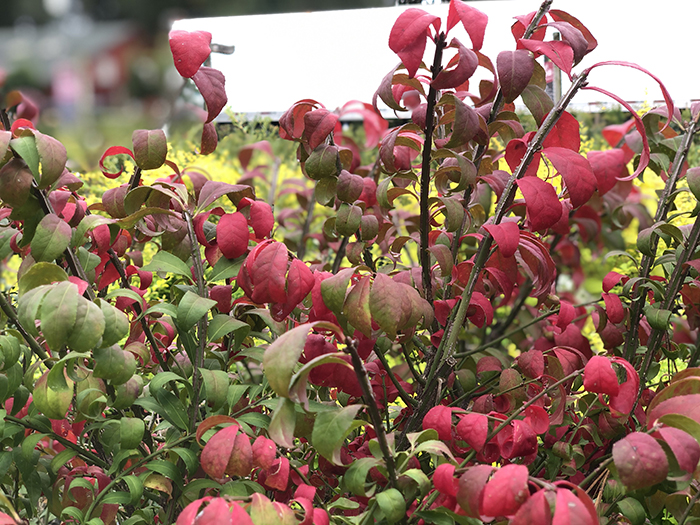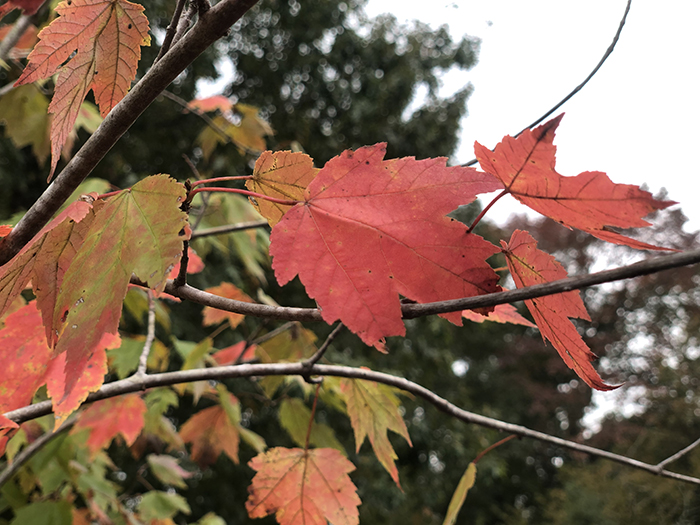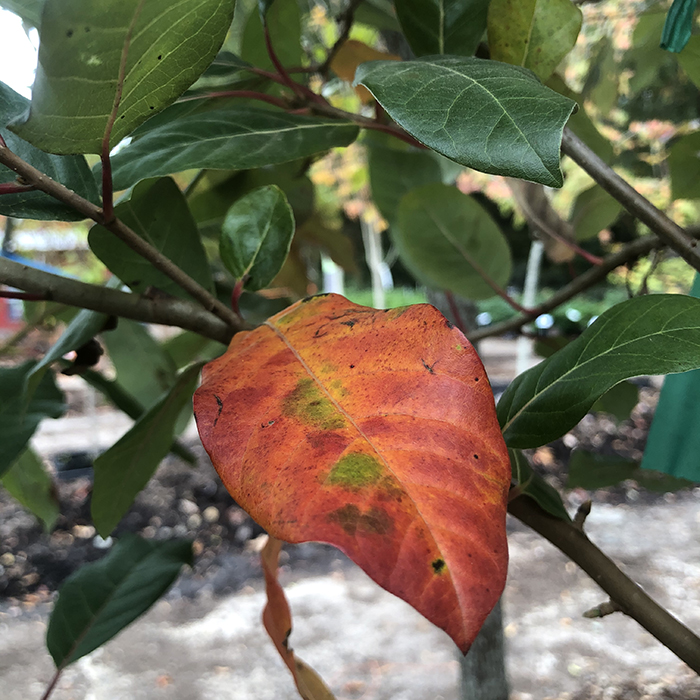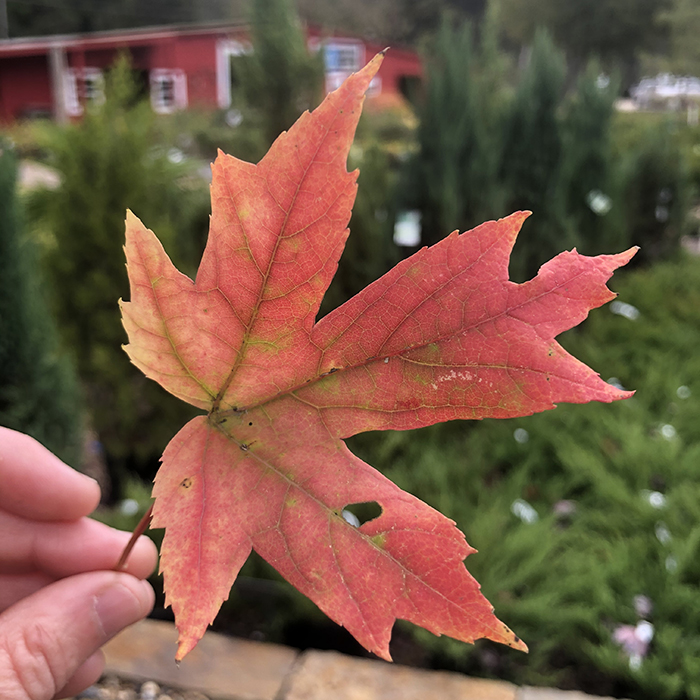Fall Foliage Colors in Arkansas

Burning Bush
We are fortunate to live in one of the few areas of the world that experience brilliant fall foliage color! Did you know that only a few regions in the Northern Hemisphere and only one region of the Southern Hemisphere enjoy this autumn coloration? It’s easy to take the years with “good” fall color for granted; and easy to forget that many people have to travel a distance to experience any at all. Speaking of that, why is it that the vibrancy of fall color can differ so greatly from year to year?

Red Maple
This may be a little technical but it’s just too interesting not to share! Chlorophyll is the green pigment responsible for the absorption of light, which fuels photosynthesis, the transfer of light to energy for the plant. During the early Fall, chlorophyll production ceases, and the chlorophyll already present breaks down. Without chlorophyll masking them, the yellow pigments, carotin and xanthophyll become visible. As far as Fall color goes, this is the process by which some plants show yellow fall color. The foliage of many plants is yellow, regardless of environmental conditions. However, in certain species such as Red Maple, fall color is a highly individual attribute. In addition, not all plants exhibit yellow leaves; take magnolias as an example. For some reason, either the breakdown or use of chlorophyll isn’t complete enough to allow the appearance of the yellow color. This process is also why the leaves of plants stored in cellars and other dark places turn yellow. Bottom line, we will always get to enjoy yellow fall color, regardless of weather conditions leading up the season.

‘Wildfire’ Blackgum
By contrast, vivid red fall color is variable, dependent on certain weather conditions. Plants known for their brilliant red fall color are such due to a red pigment called anthocyanin, which is a result of the accumulation of sugars and/ or tannins in leaves. Two factors play into red fall color; and both involve temperature. Sunny, warm fall days must occur during this time when plants are naturally producing a high amount of sugar. For vivid red color, these days need to be followed by cool night, with temperatures under 45 degrees. This time of high sugar production and the cool nights that impede its translocation, the sugars become trapped and this accumulation results in the production of the red pigment, anthocyanin. This phenomenon is apparent when looking at a tree that may only be red on one side; this is the side that received more sunlight. Other leaves may be yellow or green. Plants known for red color usually won’t exhibit it when planted in shade; they simply don’t get enough sunlight to experience this process. Another interesting facet to this is the lower growing shrubs being among the first to show fall color; this is a result of the cold air settling low on cool nights.
Warm, cloudy, fall weather, often times without much rainfall, will lessen the brilliance of fall color. As we discussed above, lack of sunlight reduces sugar production. And cloudy nights are typically warmer than clear ones, resulting in better translocation of sugars out of the leaves than during cold temperatures.

Sweet Olive
While this post is mainly about deciduous plant material, it’s important to consider evergreens too. Some leaves (or needles) of many different kinds of evergreens change color in autumn, although the process may not be conspicuous. Take for example, pine trees, which shed a portion of their needles each fall. Because many pine trees hold needles for multiple years, most are evergreen as they do not lose all their needles during the same fall season… just the older ones.
Some deciduous trees hold onto leaves until after all fall color has faded and only drop after turning brown, where as some trees lose leaves when fall color is still intense; this is an individual species trait and doesn’t relate to plant health. However, if tree or shrub leaves turn brown and remain on the tree, regardless of season, there is a serious plant health issue that needs addressing.

Red Maple
Here are some trees (and a few shrubs we just HAD to mention) that typically have showy fall color or some sort of fall interest in the landscape:
‘Wildfire’ Blackgum
This is an outstanding landscape tree with ruby red new leaves in the spring and outstanding red, gold, orange and purple fall color. During the summer months, leaves are a glossy dark green. Blackgums (also called tupelo and sourgum) are also good wildlife trees, supporting local birds and butterflies. Mature size of ‘Wildfire’ Blackgums is 30-40 ft tall and 15-25 ft tall.
‘Slender Silhouette’ Sweetgum
These columnare shaped trees have multiple desirable features; tall, narrow growth habit, interesting leaf shape and bright orange-red fall foliage color. Slender Silhouettes also produce much less sweetgum balls than native varieties. This variety grows up to 50 ft tall with a width of only 5 ft!
‘Legacy’ Suger Maple
Sugar maples have been known for their great fall color for a long time and Legacy is no exception. The Legacy variety is more drought tolerant than other varieties and is This tree grows to 50 ft in height and 35 ft in width.
‘Autumn Blaze’ Red Maple
We have native red maples in our forests and there are many improved varieties that offer specific features. All feature fall color of some shade. Autumn Blaze (large growing with vibrant orange-red fall color), Redpointe (more narrow that other varieties) and October Glory (large maple that tends to hang onto fall foliage longer) all have wonderful fall color.
Chinese Pistache
Chinese Pistache trees have a unique compound leaf and a roundish growth habit. Although fall coloration varies, it’s typically an eye-catching bright red. They are also great street trees, tolerant of a variety of soil conditions. The mature size is 25 ft tall by 25 ft wide.
Dwarf Burning Bush
This is a great large, deciduous shrub with blazing red fall color! Take a look for yourself, it’s the very first picture shown in this post. Despite the name being considered a dwarf plant, the mature size is pretty big; 6-8 ft tall and 8-10 ft wide. Give this little, big plant some room to grow!
Spring Blooming Trees with Fall Color
Ornamental cherry trees (bronze to gold) and dogwood (vibrant red in north Arkansas) trees also offer some bright fall color. Love it when trees have two seasons of interest in the landscape!
Jade Butterflies Ginkgo
All ginkgos have lovely gold fall foliage but this one is special! It’s a small growing (12-15 ft. tall, 10 ft. wide at maturity), vase-shaped ginkgo with dense branches that give it a cool texture. A fruitless male Ginkgo with inconspicuous yellow-green catkins in mid-spring. If you are looking for small tree with interesting leaves and gorgeous fall color, this one might be for you!
Sweet Olive
This evergreen shrub had small white flowers that pack a fragrant punch. Sweet Olives blooms for a long time, are blooming now in fact, and the fragrance is scentsational!
Has all of this gotten you excited to plant fall foliage materials? Visit the Trees category of our Inventory, then click the Fall Color Trees tab for options. Fall is both a great time to shop for fall foliage plants AND the ideal time of year to plant trees and shrubs in Arkansas.